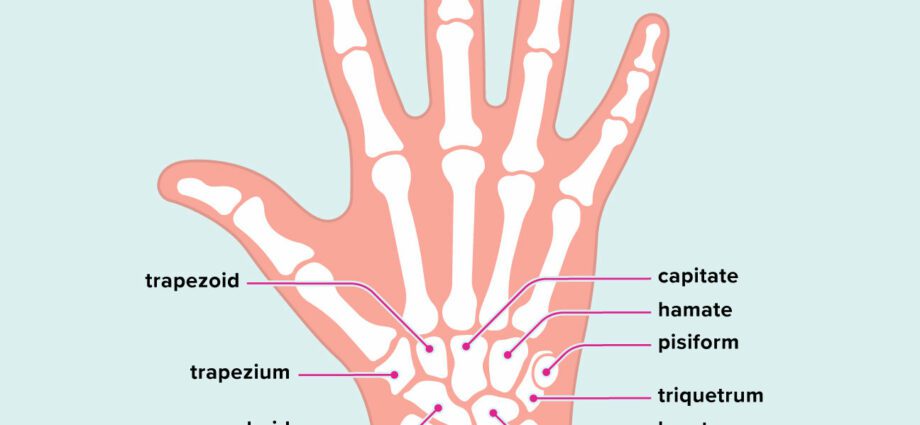Contents
Wrist
The wrist (coming from the fist) is a joint located between the hand and the forearm.
Wrist anatomy
The wrist is made up of the lower end of the radius and ulna (or ulna), as well as the carpus, itself made up of two rows of four small bones. Linked by ligaments, the carpal bones form a “tunnel” called the carpal tunnel through which the median nerve and flexor tendons of the fingers pass. The median nerve is involved in the sensitivity of the fingers and in the movements of the fingers and hand.
Wrist physiology
The wrist allows the movement of the hand in different directions:
- lateral (abduction – adduction),
- upwards (extension),
- down (flexion).
Pathologies and diseases of the wrist
fractures. The bones of the hand are easily subject to impact and fractures. Extra-articular fractures must be distinguished from joint fractures involving the joint and requiring a thorough assessment of the lesions.
- Scaphoid fracture. Carpal bone, the scaphoid can be fractured in the event of a fall on the wrist or forearm (5,6).
- Wrist fracture. Frequent, this fracture requires a rapid and adapted immobilization of the wrist to avoid displacement.
Bone pathologies.
- Kienbock disease. This disease is necrosis of one of the carpal bones when nutrient supply from the blood is interrupted (7).
- Osteoporosis. This pathology consists of a loss of bone density, usually in people over the age of 60. It increases bone fragility and the risk of fractures (8).
Musculoskeletal disorders (MSDs). The wrist is one of the upper limbs affected by musculoskeletal disorders, recognized as occupational diseases and arising from excessive, repetitive or sudden stress on a limb.
- Tendonitis of the wrist (de Quervain). It corresponds to the inflammation of the tendons in the wrist (9).
- Carpal tunnel syndrome: This syndrome refers to disorders associated with compression of the median nerve at the level of the carpal tunnel, made up of the carpal bones. It manifests as tingling in the fingers and loss of muscle strength (10).
Arthritis. It corresponds to conditions manifested by pain in the joints, ligaments, tendons or bones. Characterized by the wear and tear of the cartilage protecting the bones of the joints, osteoarthritis is the most common form of arthritis. The joints of the hands and wrists can also be affected by inflammation in the case of rheumatoid arthritis (11). These conditions can lead to deformity of the fingers.
Prevention and treatment of the wrist
Prevention of shock and pain in the hand. To limit fractures and musculoskeletal disorders, prevention by wearing protection or learning appropriate gestures is essential.
Orthopedic treatment. Depending on the type of fracture, the installation of a plaster or a resin will be carried out to immobilize the wrist.
Drug treatments. Depending on the disease, different treatments are prescribed to regulate or strengthen bone tissue.
Surgical treatment. Depending on the type of fracture, surgery may be performed with the placement of pins or screw plates. Treatment of Kienböck’s disease also requires surgical treatment.
Wrist examination
Medical imaging examination. The clinical examination is often supplemented by an x-ray. In some cases, doctors will use an MRI, CT scan, or arthroscopy to assess and identify lesions.
History and symbolism of the wrist
In certain disciplines such as dance or gymnastics, athletes seek to develop hypermobility of the joints, which can be acquired through specific training. However, this hypermobility can have negative effects. Still poorly understood and diagnosed late, ligament hyperlaxity makes joints unstable, making them extremely fragile (5).










